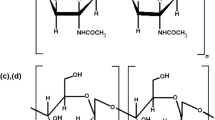Abstract
The optimal conditions for the isolation of valuable natural biopolymers were revealed. Chitosan (CH) was obtained from cysts of A. parthenogenetia in the Aral Sea and from pupae of the silkworm Bombyx mori. Chitosan was obtained from cysts of A. parthenogenetia with a molecular weight of 89 kDa, a degree of deacetylation (DDA) of 72% and a solubility of 81.62%. It has been shown that it is possible to isolate CH from silkworm pupae of sufficient purity with different molecular weights and DDAs depending on the synthesis conditions and the degree of purification. Bombyx mori CH has a higher molecular weight of 100–160 kDa, a high DDA, up to 90%, and a solubility of 88%. IR spectroscopy, X-ray diffraction and elemental analysis have shown the purity of the isolated CH from various sources. In chitin from A. parthenogenetia cysts of the Aral Sea, two types of modifications, α and β, with corresponding syngonies are observed, which confirms its polymorphic structure. The antibacterial activity of B. mori CH has been shown, which tends to expand the spectrum of suppressed bacteria with increasing concentration and have a bactericidal effect on both gram-negative and gram-positive bacteria. CH of B. mori had an immunostimulating effect on living organisms, which allows us to recommend drugs based on CH to strengthen the immune system.



Similar content being viewed by others
REFERENCES
Khitozan (Chitosan), Skryabin, K.G., Mikhailov, S.N., and Varlamov, V.P., Eds., Moscow: Tsentr Bioinzheneriya Ross. Akad. Nauk, 2013.
Caracciolo, G., Vali, H., Moore, A., and Mahmoudi, M., Nano Today, 2019, vol. 27, no. 6, p. 10. https://doi.org/10.1016/j.nantod.2019.06.001
Sheik, S., Nagaraja, G.K.;., and Chandrashekar, K.R., Mater. Today Proc., 2018, vol. 5, no. 10, pp. 21011–21017.
Wang, W., Meng, Q., Li, Q., Liu, J., Zhou, M., Jin, Z., and Zhao, K., Int. J. Mol. Sci., 2020, vol. 21, no. 2, p. 487. https://doi.org/10.3390/ijms21020487
Belbekhouche, S., Bousserrhine, N., Alphonse, V., Le Floch, F., Charif Mechiche, Y., Menidjel, I., and Carbonnier, B., Colloids Surf. B, 2019, vol. 181, pp. 158–165.
Le-Vinh, B., Minh, N., Le, N., Nazir, I., Matuszczak, B., and Bernkop-Schnürch, A., Int J. Biol. Macromol., 2019, vol. 133, pp. 647–655. https://doi.org/10.1016/j.ijbiomac.2019.04.081
Wang, W., Meng, Q., Li, Q., Liu, J., Zhou, M., Jin, Z., and Zhao, K., Int. J. Mol. Sci., 2020, vol. 21, p. 487. https://doi.org/10.3390/ijms21020487
Rashidova, S.Sh. and Milusheva, R.Yu., Khitin i khitozan Bombyx mori. Sintez, svoistva i primenenie (Chitin and Chitosan from Bombyx mori: Synthesis, Properties, and Applications), Tashkent: FAN, 2009.
Milusheva, R.Yu., Avazova, O.B., and Rashidova, S.Sh., Belok iz kukolok tutovogo shelkopryada Bombyx mori L. Vydelenie, svoistva, primenenie (Protein from Silkworm Bombyx mori L. Pupae: Extraction, Properties, and Application). Tashkent: FAN, 2020.
Mirabdullayev, I., Abdullaeva, L., Musaev, A., Zholdasova, I., Mustafaeva, Z., and Jumaniezova, N., Geophys. Res. Abstr., 2007, vol. 9, p. 772.
Aladin, N.V. and Plotnikov, I.S., Proc. Zool. Inst. Ross. Akad. Nauk, 2008, vol. 312, nos. 1–2, pp. 145–154.
Rudneva, I.I., Artemia/Prospects for Use in the National Economy, Kiev: Naukova Dumka, 1991.
Ravikumar, N.V., React. Funct. Polym., 2000, vol. 46, pp. 1–27.
Muzzarelli, R.A.A., The discovery of chitin, in Chitosan in Pharmacy and Chemistry, Muzzarelli, R.A.A. and Muzzarelli, C., Eds., Italy: Atec., 2002, pp. 1–8.
Milusheva, R.Yu., Pirniyazov, K.K., and Rashidova, S.Sh., Vestn. Tver. Gos. Univ., Ser.: Khim., 2016, no. 2, pp. 119–124.
Gamzazade, A.I., Shlimak, B.M., Sklyar, A.M., Stykova, E.V., Pavlova, S.A., and Rogozin, S.V., Acta Polym., 1985, vol. 36, no. 8, pp. 421–424.
Pogodina, N.V., Pavlov, G.M., Bunin, S.V., and Men’shikov, A.V., Vysokomol. Soed., 1986, no. 28, pp. 232–239.
Gosudarstvennaya farmakopeya SSSR. XI (State Pharmacopoeia of the USSR. XI), Moscow: Meditsina, 2012, vol. 2, p. 24.
Gosudarstvennaya farmakopeya SSSR XI (State Pharmacopoeia of the USSR. XI), Moscow: Meditsina, 1987, vol. 1, p. 175.
Klimova V.A. Osnovnye mikrometody analiza organicheskikh soedinenii. Moskva: Khimiya, 2001. 75 s.
Litvinenko, L.I. and Boiko, E.G., Biol. Vnutr. Vod, 2008, no. 1, pp. 40–48.
Bansal, V., Sharma, P.K., and Sharma, N., Adv. Biol. Res., 2011, vol. 5, no. 1, pp. 28–37.
Rinaudo, M., Prog. Polym. Sci., 2006, vol. 31, pp. 603–632.
Kumar, M.R., Muzzarelli, R.A.A., Muzzarelli, C., Sashiva, H., and Domb, A.J., Chem. Rev., 2004, vol. 104, pp. 6017–6084.
Yugai, S.M., Shakhobutdinov, S.Sh., Atakhanov, A.A., and Rashidova, S.Sh, Khim. Zh. Kaz., 2019, vol. 67, no. 3, pp. 254–265.
Khazhibaev, K.G. Berdimbetova, G.E., Karlybaeva, B.P., and Oshchepkova, Yu.I., Universum: Khim. Biol., 2019, no. 9, p. 63. http://7universum.com/ru/nature/archive/item/7769.
Il'ina, A.V., Varlamov, V.P., and Ermakov, Yu.A., Dokl. Akad. Nauk, 2008, vol. 421, no. 2, pp. 199–201.
Chen, Y.M., Chung, Y.C., Wang, L.W., Chen, K.T., and Li, S.Y., J. Environ. Sci. Health, Part A: Toxic/Hazard. Subst. Environ. Eng., 2002, vol. 37, p. 1379.
Funding
This work was financed from the budget of the institute (Institute of Chemistry and Physics of Polymers of the Academy of Sciences of the Republic of Uzbekistan, Uzbekistan). No additional grants were received to conduct or direct this specific study.
Author information
Authors and Affiliations
Corresponding author
Ethics declarations
ETHICS APPROVAL AND CONSENT TO PARTICIPATE
The maintenance and handling of laboratory animals was carried out in accordance with the requirements of the provisions of the European Convention for the Protection of Vertebrate Animals Used for Experimental and Other Scientific Purposes and the legislation and adopted standards of the Academy of Sciences of the Republic of Uzbekistan.
CONFLICT OF INTEREST
The authors of this work declare that they have no conflicts of interest.
Additional information
The article has been presented at the XVI All-Russian Conference with International Participation “Modern Perspectives in Chitin and Chitosan Studies” (RosChit-2023, https://roschit23.ru).
Publisher’s Note.
Pleiades Publishing remains neutral with regard to jurisdictional claims in published maps and institutional affiliations.
Rights and permissions
About this article
Cite this article
Milusheva, R.Y., Akhymbetova, G.D. & Rashidova, S.S. Obtaining Chitosan from Chitine-Containing Raw Materials in Uzbekistan and Research on Antimicrobial Properties. Appl Biochem Microbiol 60, 216–225 (2024). https://doi.org/10.1134/S0003683824020108
Received:
Revised:
Accepted:
Published:
Issue Date:
DOI: https://doi.org/10.1134/S0003683824020108




